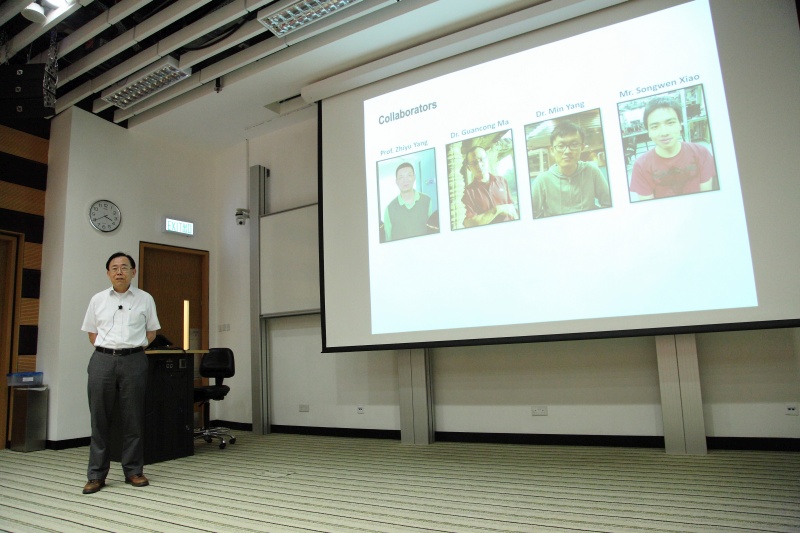Hybrid Resonant Acoustic Metasurface and Its Functionalities
IAS Commons provides boundless opportunity for growth. It is based on a cross-curricular perspective that recognizes literacy, numeracy, knowledge, thinking, communication, and application as foundations for advanced study. IAS Commons is a physical and virtual catalyst where inquiry, imagination, discovery, and creativity come alive and become central to growth.
We are proud to have the privilege of inviting Prof Ping Sheng, Dr William M. W. Mong Professor of Nanoscience and IAS Senior Fellow, to talk about Hybrid Resonant Acoustic Metasurface and its Functionalities. To encourage casual and more in-depth interactions, refreshments are served after the talk.
Abstract
An impedance-matched surface has the property that an incident wave generates no reflection. Here the speaker demonstrates that by using simple construct, an acoustically reflecting surface can acquire hybrid resonances and becomes impedance-matched to airborne sound at tunable frequencies, so that no reflection is generated. Each resonant cell of the metasurface is deep-subwavelength in all its spatial dimensions, with its thickness less than the peak absorption wavelength by two orders of magnitude. As there can be no transmission, the impedance-matched acoustic wave is hence either completely absorbed at one or multiple frequencies, or converted into other form(s) of energy such as electrical current. A high acoustic-electrical energy conversion efficiency of 23% is achieved.
About the speaker
Prof. Sheng Ping received his BS in Physics from the California Institute of Technology and PhD in Physics from Princeton University. He served as the Head of Department of Physics at the Hong Kong University of Science and Technology from 1999 to 2008 and is currently the Dr William M W Mong Professor of Nanoscience, a Fellow of the American Physical Society, and a Member of the Asia Pacific Academy of Materials. In 2002, he was awarded Technology Leader of the Year by the Sing Tao Group. He is the 2013 Brillouin Medal winner for his seminal contribution to locally resonant acoustic metamaterials. Prof Sheng has published over 375 refereed journal publications and presented over 115 keynote or invited talks at international meetings and conferences. He also has 26 patents and is the author of a monograph on Wave Scattering, Localization, and Mesoscopic Phenomena (Springer, 2006).
Prof. Sheng's research is in the area of condensed matter physics. He has pioneered the study of liquid crystal-substrate interaction while at the RCA David Sarnoff Research Laboratory, and established the mechanisms of charging-energy correlated hopping and fluctuation-induced tunneling conduction in disordered materials. While at Exxon Corporate Research Center from 1979-1994, Prof Sheng's interest broadened into wave interaction and scattering in disordered systems, and porous media. The study of nanotechnology became his main focus after joining the HKUST in 1994, where he led the efforts in the discovery of superconducting behavior in ultrathin carbon nanotubes, and the giant electrorheological effect in suspensions of nanoparticles. He is also the inventor of locally resonant sonic materials that can break the mass density law in shielding low frequency sound. More recently, Prof Sheng and his colleagues resolved the classical problem of moving contact line in two phase immiscible flows, by applying Onsager's principle of minimum energy dissipation to the derivation of hydrodynamic boundary conditions.
The Institute of Nano Science and Technology (INST), established in 2001 with Prof. Sheng as the founding Director, is the first such research institute in Hong Kong. Its mission is to carry out fundamental research and innovation in nano science and technology. Besides the accomplishments in carbon nanotubes and electrorheological fluids, which were reported world-wide in Washington Post, New Scientist, Science Now, Nanotechweb, PhysicsWeb, etc., INST also boasts as its achievements the discovery of room temperature UV lasing from zinc oxide nanocrystals, the discovery of the giant Hall effect in granular metal films, and the commercialization of the visible-blind UV detector based on semiconductor heterostructures.
Prof. Sheng is a division associate editor of Physical Review Letters; a member of the Executive Editorial Board, Solid State Communications; as well as an editor of the New Journal of Physics. He is a Senior Fellow of the HKUST Jockey Club Institute for Advanced Study, a national board member of Kavli Institute of Theoretical Physics; visiting Chair Professor of the National Chiao Tung University, as well as an advisory board member of the Research Center for Applied Sciences, Academia Sinica. He has served, and still serving, as a member of consulting committees to various universities in China.







